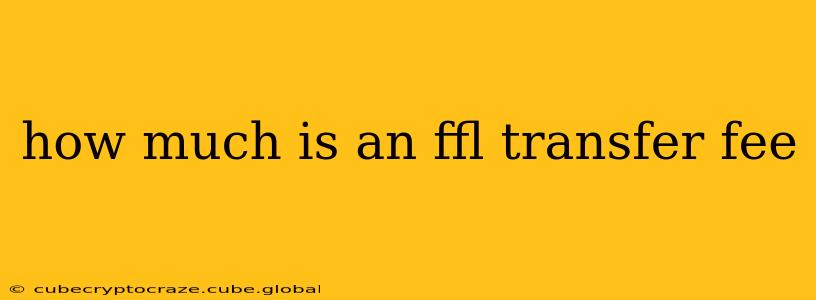How Much is an FFL Transfer Fee? A Comprehensive Guide
The cost of an FFL (Federal Firearms Licensee) transfer fee varies considerably depending on several factors. There's no single, nationwide price. Understanding what influences this cost is crucial before heading to your local gun shop.
Factors Affecting FFL Transfer Fees:
Several factors contribute to the final price you'll pay for an FFL transfer:
- Location: FFL fees vary significantly by geographic location. Rural areas may have lower costs than those in densely populated urban centers with higher overhead.
- FFL Dealer: Each dealer sets their own pricing structure. Some may charge a flat fee, while others might base their fee on the type of firearm or the amount of paperwork involved. Larger chains may have standardized fees, whereas smaller, independent shops might have more variable pricing.
- Firearm Type: The complexity of the firearm and the associated paperwork can influence the fee. For example, transferring a handgun might cost less than transferring a long gun or an NFA item (National Firearms Act regulated items like suppressors or short-barreled rifles).
- Demand: High demand for FFL transfers, especially during periods of increased gun sales, can sometimes lead to slightly higher fees as dealers face increased workload.
- Additional Services: Some dealers may include additional services in their transfer fee, such as cleaning the firearm or performing a basic function check. Others may charge extra for these services.
What Services are Included in the Transfer Fee?
Typically, the FFL transfer fee covers the dealer's time and effort in completing the necessary paperwork, conducting the background check through the National Instant Criminal Background Check System (NICS), and ensuring compliance with all federal and state regulations. This process involves verifying your identity, ensuring you are legally eligible to purchase the firearm, and properly recording the transaction in their records.
What are Common FFL Transfer Fee Ranges?
While pinpointing an exact average is difficult due to the many variables, you can generally expect to pay anywhere from $25 to $75 for a standard firearm transfer. However, prices outside this range are not unheard of, particularly for more complex transfers or in specific geographic areas. It's always best to contact several local FFL holders to compare prices before committing to a transfer.
How Can I Find an FFL Dealer Near Me and Compare Prices?
Several online resources can help you locate FFL dealers in your area. However, the best approach is to contact several dealers directly to inquire about their transfer fees and services. This allows you to compare pricing and understand what's included in each fee.
Are There Any Hidden Fees I Should Be Aware Of?
While the transfer fee itself is usually the largest expense, be aware of potential additional costs, such as state-specific taxes or fees, which can add to the overall cost. It's essential to ask the FFL dealer upfront about any additional charges to avoid surprises.
What if the FFL Dealer Charges More Than I Expected?
If a dealer’s fee seems unusually high, don't hesitate to contact other dealers for price comparisons. Competition among FFL holders can help you secure a more favorable price for the transfer service.
In conclusion, the cost of an FFL transfer fee is not fixed. It's crucial to shop around, compare prices, and understand what services are included before making a decision. Always remember to comply with all federal and state regulations regarding firearms ownership and transfers.
